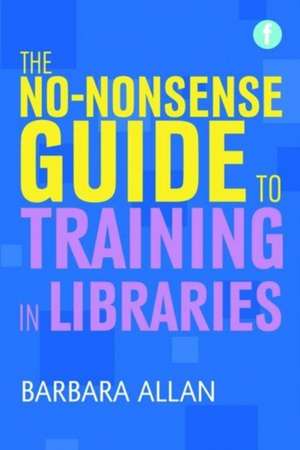No-nonsense Guide to Training in Libraries: Facet No-nonsense Guides
Autor Barbara Allanen Limba Engleză Hardback – sep 2023
In order to make an impact with their customers, library staff must be well trained and up-to-date. Training is often delivered by library managers, development officers and trainers who may have limited budgets with access to few resources. This accessible guide uses case studies and examples of best practice from public, school, academic, special and government libraries to help library and information workers deliver excellent training practice.
Increasingly, library and information staff are being asked to do more and more with fewer resources. In the context of higher education and further education, library and information workers are often involved in training large, diverse groups of more than 100 students, who may have limited resources. In public libraries, library staff may be involved in delivering a wide range of training activities to extremely diverse groups.
Preț: 787.96 lei
Preț vechi: 1260.56 lei
-37% Nou
Puncte Express: 1182
Preț estimativ în valută:
150.77€ • 157.43$ • 124.50£
150.77€ • 157.43$ • 124.50£
Carte nepublicată încă
Doresc să fiu notificat când acest titlu va fi disponibil:
Se trimite...
Preluare comenzi: 021 569.72.76
Specificații
ISBN-13: 9781783303168
ISBN-10: 1783303166
Pagini: 224
Dimensiuni: 156 x 2340 x 17 mm
Greutate: 0.23 kg
Ediția:1
Editura: Facet Publishing
Colecția Facet Publishing
Seria Facet No-nonsense Guides
Locul publicării:Oxford, United Kingdom
ISBN-10: 1783303166
Pagini: 224
Dimensiuni: 156 x 2340 x 17 mm
Greutate: 0.23 kg
Ediția:1
Editura: Facet Publishing
Colecția Facet Publishing
Seria Facet No-nonsense Guides
Locul publicării:Oxford, United Kingdom
Public țintă
Professional Practice & DevelopmentCuprins
1. Introduction Introduction to this chapter Introduction to the book Contribution of training to library and information services Benefits of training The training cycle and the planning stage The financial side of training Legal issues Structure of the book Summary References and additional resources PART 1: TRAINING PRACTICES 2. Different approaches to learning and teaching Introduction Three approaches to learning and teaching A model for workplace learning programmes Theories of learning Bloom’s Taxonomy of Learning Levels of competence Summary Notes References and additional resources 3. Making training interesting Introduction Action planning Activities Case studies Demonstrations Discussion groups Drop-in sessions Games Group work Guest speakers Hands-on sessions Ice-breakers Inquiry-based learning Lectures and presentations Problem-based learning Stories and metaphors Surveys and questionnaires Treasure hunts Using a combination of methods Summary References and additional resources 4. Use of different technologies to support training practices Introduction Apps Audience response systems Audio files Blogs Games Interactive whiteboards Mind mapping Mobile learning Podcasts PowerPoint QR codes Screen recording Screen sharing Skype Social networking tools Surveys or questionnaires Twitter Videos Virtual learning environments Virtual talks Virtual visitor Web-based training Web conferencing Webinars Web portals Wikis Summary Notes References and additional resources 5. Making it happen Introduction Thinking about participants Design principles Designing face-to-face sessions Impact of learning style preferences on training styles Managing session timings Evaluation of training Marketing and promoting training programmes Summary References and additional resources 6. Delivering face-to-face training sessions Introduction Getting started Different ways of involving everyone in the training process Managing the learning process Questions Ending the learning process Teaching large groups Making database training interesting Working with challenging learners Summary References and additional resources 7. E-learning and blended learning Introduction E-learning Design of e-learning programmes Web-based tutorials Learning groups and communities Blended learning Design of blended learning programmes E-tutoring Evaluation of e-learning and blended learning Summary References and additional resources PART 2: LEARNING IN THE WORKPLACE 8. Learning and development in the workplace Introduction 90+ approaches to learning and development in the workplace 360 degree feedback Accreditations Action learning Action planning Analysing mistakes Appraisal processes Apps Asking advice Asking and answering questions Audio recordings Benchmarking Blogs Book reviews Briefing papers Briefing sessions Cascade training Celebrating success Coaching Communities of interest and practice Competitions and prizes Complaints Conferences Covering for holidays Crises Critical friend Delegation Demonstrations Displays E-bulletins E-learning Electronic mailing lists E-mails E-portfolio Evaluating different products Exchanges Exhibitions Exit interviews External funding Feedback Fishbone diagram Focus groups Frequently asked questions Gap year Induction Instructions Internet Interviews Job rotation Key performance indicators Learning boxes Learning contracts Learning conversations Learning journals Meetings Mentoring Metaphors Mind mapping Networking Online discussion groups Online tutorials Organizing events Personal development planning Personal development portfolios Playing cards Presentations Professional journals Professional organizations Project work Promotion QR codes Quality assurance activities Quizzes Reading Reflection Retreats or residentials Rich pictures Secondment Self-assessment tools Setting deadlines Speed networking Sticky notes Study tours SWOT analysis Teamwork Training a colleague Twitter Video clips Visits Wikis Work-based learning qualifications Work shadowing Working parties Writing YouTube Notes References and additional resources
Notă biografică
Professor Barbara Allan is Dean of Westminster Business School. Her background includes managing workplace and academic libraries.
Descriere
Straightforward and practical guidance for library and information workers in all sectors who are involved in training users, colleagues or other groups. This accessible guide uses case studies and examples of best practice from public, school, academic, special and government libraries.








